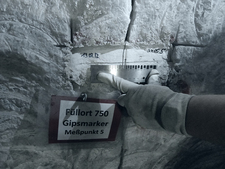Site monitoring
The state of the Asse II mine is permanently being monitored. To ensure that one can continue to operate the mine in an orderly and safe way, the BfS monitors the state of the rock in the Asse II mine and the saline solutions entering the mine.

![]() A plaster marker in 750 meters depth is checked. Plaster Markers are a tool for monitoring the development of cracks in the Asse mine
A plaster marker in 750 meters depth is checked. Plaster Markers are a tool for monitoring the development of cracks in the Asse mine
Monitoring of the rock state
To monitor the rock state, the mine is geologically surveyed both above ground and underground. Geotechnical and micro-seismic measurements provide information about deformation and stresses of the ground. To monitor how the backfilling of roof clefts affects the rock state, the temperature and humidity of the rock and the salt powder in the chambers are measured additionally.
More than 150 measuring stations have been established in the mine openings to monitor the rock. Part of these stations can be monitored from above ground in online operation.
Monitoring of saline solutions
To monitor the inflow of saline solutions, their volume is measured at the various collecting points. For this purpose, an online system continuously registering the volume flowing in has been installed at the main collecting point on the 658-m level. Temperature and density of the solution are measured on a daily basis at all significant collecting points on the 658, 725 and 750-m levels, for possible changes in the composition of the solution can immediately be recognised from its density.
Also, samples are taken and analysed on a regular basis in order to monitor the material composition of the solutions. The composition provides information about the origin of the solution. Taking and analysing samples is carried out weekly at the main collecting point and monthly on the deeper-lying levels.
Observation of shafts I and III
In the scope of the site monitoring also the "flooded" shafts Asse I and Asse III situated about 600 m to the west and 3 km to the east of Asse II are monitored. In both shafts the water levels and the composition of the saline solutions are measured on a regular basis in order to check whether and to what extent the shafts are connected with groundwater-bearing layers.
Site monitoring ensures safe operation of the mine
The site monitoring serves mining operations. It must be distinguished from the radiological monitoring of the mine and the emission and immission monitoring of the environment, the latter being the task of operational radiation protection.

